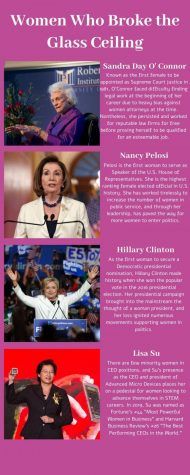The glass ceiling continues to limit women
January 9, 2020
A woman is appointed CEO of a well-known company, and from the outside, it appears she is making great strides in her career. Later, the company becomes a bankrupt failure, and everyone blames the woman, using rhetoric implying that putting women in charge of companies is a recipe for disaster. However, what the public doesn’t see is how the company was doing in the first place. According to Vox, in most cases when women reach the upper ranks of power, they are put into unpredictable positions and thus have a higher likelihood of failure. This phenomenon of invisible barriers hindering the advancement of women is known as the glass ceiling effect.
The term “glass ceiling” denotes an invisible obstacle in corporations that makes it nearly impossible for women to rise in ranks. It’s a metaphor used to describe the resistance women are met with when trying to get promotions, pay raises and opportunities. Minority women have to face a double obstacle in breaking the glass ceiling because they lie at the intersection of two marginalized groups: women and people of color.
“There’s a lot of stigmas that women face in leadership roles, and because companies are usually risk-averse, a different demographic is avoided for promotion,” senior Yifan Chen said. “It’s difficult to prove yourself to a world that stereotypes you with unconscious bias.”
A New York Times article revealed in July earlier this year that women and minorities are brought into leadership positions when things are going badly because they aren’t privileged enough to reject opportunities. A white male candidate may be able to say they don’t want to clean up the mess a company left behind, but women and minority candidates will often take the opportunity because they feel this may be their only shot.
“Hiring a woman CEO, especially someone who potentially has endured being overlooked for promotions and advancement, can lead to a hungrier and mo re apt leader,” English teacher Bobby Nelson said. “Adena Friedman, the head of the large trading platform Nasdaq, stated that because she was overlooked often, she took every possible chance to make her company great once hired.”
re apt leader,” English teacher Bobby Nelson said. “Adena Friedman, the head of the large trading platform Nasdaq, stated that because she was overlooked often, she took every possible chance to make her company great once hired.”
Traditional gender stereotypes also play a role in hindering women in power positions. Society views women as inferior leaders because they are deemed to spend more time with family and fall into the “likeability trap” where they must prove they are tough but likable at the same time. Similarly, they may fall into a “double-bind” in which women are disliked for being direct and decisive instead of nice and nurturing leaders.
“Traditional gender stereotypes cause women to doubt themselves and men to disregard a woman’s input,” sophomore Mahima Suresh said. “Unfortunately, society also places many expectations on men to be natural leaders and breadwinners, which in turn results in men treating women indifferently.”
To combat the glass ceiling effect, companies should actively foster an atmosphere of equality and give women higher positions they have earned. However, some believe that women shouldn’t be hired just for diversity purposes.
“I think you have to be conscious of who you hire and why you hire them,” Nelson said. “Both genders have the ability to be great or horrible leaders. Companies should cultivate inclusivity and hire those they believe are qualified based on merit.”
While gender shouldn’t be a primary reason to hire, the exclusion of minority groups can ultimately hurt a company from advancing. Women must be given equal consideration in jobs based on their capabilities, not their gender.
“Through the repression of women, we lose the ability to have diverse perspectives and ideas that help move us forward as a society,” Suresh said. “We are constantly trying to make progress and move ahead, and this is not going to be possible when we exclude a key group of people.”










